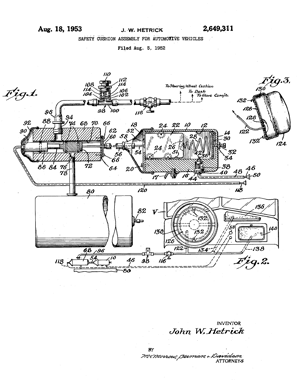 John Hetrick’s invention was the first prototype of today’s modern air bags and derived from an accident on a Sunday afternoon drive. In the spring of 1952, Hetrick, his wife and daughter went for a car ride in their 1948 Chrysler Windsor. The car veered into a ditch on the side of the road to avoid an on-road collision.
John Hetrick’s invention was the first prototype of today’s modern air bags and derived from an accident on a Sunday afternoon drive. In the spring of 1952, Hetrick, his wife and daughter went for a car ride in their 1948 Chrysler Windsor. The car veered into a ditch on the side of the road to avoid an on-road collision.
Hetrick recalled “As I applied the brakes, both my wife and I threw our hands up to keep our daughter from hitting the dashboard … during the ride home, I couldn’t stop thinking about the accident. I asked myself: ‘Why couldn’t some object come out to stop you from striking the inside of the car?'”
As a retired industrial engineer technician, Hetrick was concerned that there was not a device in the car to cushion the impact of an accident between the vehicle’s interior and the passengers. Hetrick used his experience working with the Navy to create a safety device for vehicles. He received U.S. patent 2,649,311 for “safety cushion assembly for automotive vehicles” on August 18, 1953.
German inventor, Walter Linderer received German patent 896,312 on November 12, 1953. Linderer’s system involved a compressed air system, which was released by the driver or bumper contact. Later research concluded that compressed air could not expand and fill the bag fast enough for maximum safety.
Both Ford and General Motors experimented with inflatable safety systems but encountered two problems with the invention. There were issues with the detection of collisions and the inflation of the airbag. Also, the airbags themselves were causing injuries to passengers.
 Mechanical engineer, Allen Breed, invented the first electromechanical automotive airbag system in 1968. This device was a reliable safety sensor and was cheap, at the cost of $5. Breed continued to improve on his inventions and obtained patent 5,071,161 for “air bag restraint system with venting means.” The venting element decreased the likeliness of secondary injuries to passengers from the air bag.
Mechanical engineer, Allen Breed, invented the first electromechanical automotive airbag system in 1968. This device was a reliable safety sensor and was cheap, at the cost of $5. Breed continued to improve on his inventions and obtained patent 5,071,161 for “air bag restraint system with venting means.” The venting element decreased the likeliness of secondary injuries to passengers from the air bag.
The invention of the airbag was slow to catch on. As a new invention, in the 1950s, there was little experimentation with the new safety system. An interest in air bags rocketed in the 70s due to an expansion in car use and an increase in traffic accidents throughout the 60s. Breed’s effective and cheap invention also contributed to the rise in the 70s.
In 1971, Ford incorporated air bags into several cars for testing and two years later, General Motors tested air bags on the 1973 model Chevrolet. These cars were only sold for government use. In 1973, the Oldsmobile Toronado was the first car with air bags intended for the public. Chrysler was the first company to offer air bags as a standard device in their cars and since 1998, airbags have been mandatory equipment for vehicles.
